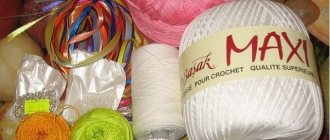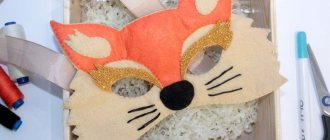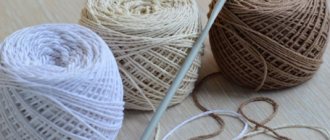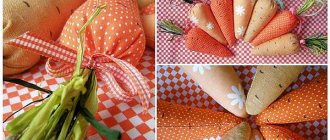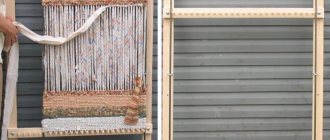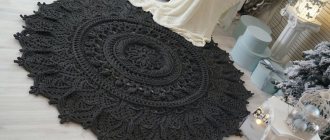Baby sling beads are very easy to make; the main materials are beads, threads, and a hook. A detailed description of the process and a diagram for creating such an accessory will help even a novice craftswoman make it.
A bright decoration made from natural materials performs several functions at once, helping both the child, the mother, and even the father when carrying the baby in a sling or in his arms. And if such a decoration is made with your own hands, it can become a kind of talisman for the little one, and will be preserved for many years as a memory.
Why are baby sling beads needed?
Sling beads, as the name suggests, are mainly hung on baby slings - devices for carrying babies. They perform not only a decorative function, but also help to cope with the child during walks or trips.
Main functions of the baby sling bus:
- distracting the baby's attention from the mother during walks, feeding, and home activities;
- preventing the child from pinching, biting and pulling the mother’s hair;
- development of fine motor skills, spatial thinking.
Instead of grabbing mom's hair or scratching her, demanding attention during a walk or important activity, the baby is distracted by bright beads of different sizes. This accessory is often worn by dads, fully appreciating its usefulness.
Since baby sling beads are made only from natural materials, biting and tugging at such beads will not cause harm. They can be used separately from the sling, hung on a stroller, or placed in the baby’s crib. Some beads may contain rattling or rustling filling, and then the accessory also becomes a soothing rattle.
What is it and what are the manufacturing methods?
How to make baby sling beads with your own hands? The term “sling beads” usually refers to costume jewelry, which in its shape resembles ordinary jewelry, but differs from the latter in size and production materials. The decoration got its name due to the fact that it was originally used as a decoration-toy for a sling, which should distract the child. At the same time, this decoration can be freely hung on a stroller, cradle, and backpacks for transporting the baby. Recently, this type of jewelry has become popular among young people - boys and girls make similar symbolic jewelry of various shapes and wear it as talismans.
If the child has become older (past the age of a baby), then this thing will continue to become a toy for him; it can be hung or placed on various furniture or other objects in the play area. With a creative approach, a child will be able to use this toy to learn colors, shapes, and develop his senses by touching and examining the object.
There are many variations of this toy, some of which require different materials and manufacturing techniques.
People (mostly girls and young women) make babywearing beads with their own hands, and the master class is conducted by professionals in making these toys. Several simple options for making this jewelry:
- Large wooden beads are used as the basis. They are also the main decoration. Instead of wooden beads, you can use any carved wooden decorations that are similar in size.
- The base is made of wool, cotton or linen threads. They are used to knit balls or bead decorations of any other shape. At the same time, they need a filler that will maintain the shape of the decoration and will securely fix the toy on the thread. In some elements you can sew mini rattles or other things that make sounds (for example, rustling ribbons, bells, etc.).
- Combined option. In this case, baby slings are made by alternating wooden and knitted elements. At the same time, the schemes for such options can be varied, so you should not look for or “spy” on how others do similar things, but you should just show your imagination.
- Another simple option that can be implemented by a person without special knitting skills is to make “pads” with various patterns embroidered on the sides.
Preparation of materials
Crocheted sling beads (diagrams and descriptions of which are presented below) are made from simple, but always safe for the child materials. And safety lies not only in non-toxicity, but also in strength. You should not use glass, ceramics, metal fittings, beads or very small beads, polymer clay, felt.
What you will need to make a baby sling:
- beads of different sizes made of wood;
- cotton threads for knitting;
- ribbon or waxed cord as a base;
- various decorative elements - wooden beads in the form of animal figures, buttons, shells, knitted bags with various fillings.
It is important to use wooden elements in babywearing beads - the material is safe for the child and will not cause allergies if it gets into the mouth. Of course, the use of varnish or coloring on the surface of the beads is prohibited. The elements themselves must be large enough so that the child does not accidentally swallow them.
If, for example, shells are used in beads, they must be boiled and disinfected several times. It is also better to use buttons from natural materials. It is also worth remembering that the beads will have to be washed often - the threads must be of high quality, 100% cotton, and not fade when wet. Items and fillers that may swell or dissolve in water should not be used.
| What yarn is suitable for baby slings? | |
| Yarn "Chamomile" | Spinning and thread mill named after S. M. Kirov, production - St. Petersburg. The price per skein starts from 500 rubles. in specialized stores. An excellent option in terms of price and quality ratio. |
| Yarn “Pekhorka successful” | The Pekhorskaya factory is located in the Moscow region. The threads are distinguished by their color fastness and ease of use. Price – from 1000 rub. per skein from partner stores. |
| Yarn "Lily" | Manufactured in China. Convenient for working on complex patterns. You can order it at any craft store. Price – from 1500 rub. |
The best option is to use mercerized cotton thread for knitting a baby sling. Tightly twisted, high-quality dyed threads will be easy to work with and will not lose their appearance with frequent washing and baby playing. Iris threads or ordinary floss should not be used for knitting. This is due to the low wear resistance of the material and inconvenience in operation - the threads are too thin, often twist, and inexpensive material can fade.
Ideas for inspiration
Photo of a wonderful version of a baby sling, as a themed toy, made in a marine style:
"Caterpillar":
"Berry scattering":
"Sweet couple":
Making baby sling beads has long gone beyond the scope of an ordinary hobby. For many, this activity has become a successful business project that will suit different categories of people. For example:
- housewives;
- young mothers on maternity leave;
- students who do not yet have the opportunity to find a job;
- and simply creative people who enjoy the creative process.
Article on the topic: Knitting bags. Crochet Mania's Bags Magazine
Approximate cost:
- the price of consumables for making one baby sling ranges from approximately 200 to 300 rubles;
- the price for a finished handmade product will be from 700 to 800 rubles;
- The time it takes to make one bead by an experienced craftsman is about 3-4 hours.
The profit from the sale of one product will be about 500 rubles. with the possibility of increasing it. A serious approach to business and a clear business plan can turn additional income into good earnings.
Every young mother wants the best for her child. And what could be better than a handmade toy, into which all the love and care for your baby has been invested. Sling beads are not just fun for a little person. These bright beads are mother’s little helpers that will calm, entertain and teach the baby something new.
Required Tools
Sling beads are most often crocheted. The work is easy, quick, and convenient patterns and descriptions of the knitting process can be quickly found in master classes from experienced craftswomen. To choose a crochet hook, you need to pay attention to the density of the yarn. For example, with a density of 200 m/50 g or 300 m/70 g, a hook with a diameter of 1.5 mm will do. For thinner threads, such as Iris, you can use a tool with a diameter of 1.25 mm.
Tying beads will be more accurate if you use several hooks of different sizes. When starting to knit, use the hook that fits the yarn, and when tying narrow parts and decreasing loops, use a hook of a smaller diameter. For example, if the main rows are cast on with a 1.5 mm hook, then when decreasing the loops it is better to take a tool with a diameter of 1.25 mm.
It is also important to look at the length of the tool, whether it has a plastic or rubberized handle, and the sharpness or smoothness of the hook itself. Here, each craftswoman chooses the most convenient option.
Knitted oak leaf
In the description, the leaf is knitted from three colors of yarn - it is autumn. If you wish, you can turn it into a spring one by knitting it entirely from green yarn.
We knit a cord 2.5 cm long using 3-point knitting needles. Further knitting is carried out on the same loops:
- 1st row: cast on with knitting needles 5 stitches. cord set, 7l., 1i. We only have 8 p.;
- 2 rub. (front side): cast on with knitting needles 5p., 6p., remove 1p. purl, 6l. We have 13p.
In all the following persons. R. The central loop should be removed as a purl stitch. We continue with knitting needles:
- 3rd: persons;
- 4p.: 6p., remove with knitting needles 1p., 6p.;
- 5r.: like 3r.;
- 6r.: like 4r.;
- 7th: closed 2p., 11l. Total work 11p.
- 8r.: closed 2p., 4l., remove 1p., 4l. Total 9p.
Next 2p. we knit with knitting needles, changing the number of loops. Let's continue:
- 11p.: cast on with knitting needles 2p., 9l. Total 11p.;
- 12p.: cast on with knitting needles 2p., 6l., remove 1p., 6l. We have 13p.
Next 2p. we knit with knitting needles without changing the number of stitches. In the second of these rows we move to the next color of yarn. We continue with knitting needles:
- 15r.: close 3p., 10l. Only 10 p.;
- 16r.: closed 3p., 3l., remove 1p., 3l. 7p left.
- Next 2p. we knit with knitting needles without changing the number of loops. Then:
- 19 rubles: dial 2p., 9l. Total 9 p.;
- 20r.: dial 2p., 5l., remove 1p., 5l. Total 11p.
Next 2p. we knit with knitting needles without changing the number of loops. In the second of these rows we move to the next color of yarn. We continue with knitting needles:
- 23r.: closed 3p., 8l. Total 8 p.;
- 24 hours: closed 3p., 2l., remove 1p., 2l. Total 5p.
- Next 2p. we knit with knitting needles without changing the number of loops. Then:
- 27r.: x3, remove 1p., 2p. in 1l. Total 3p.
Close the remaining loops.
Product options
Crochet sling beads (diagrams and descriptions may suggest a basic version of the product) can be transformed to suit your own style or needs.
What kind of baby slings you can make with your own hands:
- Classic version – with wooden beads tied with cotton thread. Knitted and wooden beads can be alternated. The beads can be tightly strung on a cord or placed far apart from each other and held in knots.
Crochet baby sling beads. Schemes and descriptions are further in the article. - Baby sling beads with a rattle - elements with rattling filling inside are strung between the classic beads.
- Beads with various decorative elements - knitted fruits and vegetables, cute wooden animals, shells, buttons. This decor will help the baby expand his horizons.
- A pacifier strung on a cord between beads is another great option to soothe the baby on a long journey or while the mother is working. In this version of the product, it is important to constantly monitor the cleanliness of the nipple.
- Babywearing beads with soft knitted beads that can be kneaded by hand. Such elements develop fine motor skills well, but are suitable for older children who have already learned to put inedible objects in their mouths.
Any additional elements can be combined with each other. For example, using a small plastic carabiner, you can attach a pacifier to the product, and alternate rattle beads with soft elements.
Filling options for baby slings:
- rice, buckwheat or other rustling cereals;
- small pebbles;
- candy wrappers;
- small bells;
- wooden rings or other pendants;
- beeping keychains;
- soft filler for toys;
- music button from an old toy.
Bulk elements are well suited for sewing into canvas bags as soft, wrinkled beads. This also includes beads with soft filling for toys and various dense but rustling wrappers. To make a rattle, rattling elements can be placed in a Kinder Surprise container. The plastic used in these containers is food grade and is completely safe. Moreover, such a container will be difficult for the baby to open to get the contents.
A bell or music button can be sewn into a bead with soft filling. The main thing is that the knitting on such beads was quite dense, and the filling did not come out of it after washing. Baby slings with elements such as cereals, music buttons, and paper fillings cannot be washed. They can be used to decorate a baby’s stroller or playpen so that the product does not get dirty so quickly, or for older children.
Toy for baby
Sling beads are designed for small children and often end up in their mouths
Therefore, it is very important to choose high-quality and safe material for their manufacture.
Beads
The most important thing is the beads. Different materials are used for their production.
The best ones, of course, are wooden ones. The main thing is that they are made from whole wood, and not from pressed sawdust. And the beads should not be treated with varnish, paint or any kind of spraying. The best are juniper fragrant and ecological beads.
Beads can be plastic or acrylic. In this case, you need to make sure the quality of the material and the absence of an unpleasant odor.
Silicone beads are a great option for quick results. They are bright, children like them and are a great help when teething.
Related article: Topiary made from beads: master class with photos and videos
Yarn can only be made from cotton. This is a safe material with a wide color palette.
How to tie a bead for a baby sling
Crochet sling beads (diagrams and descriptions are presented in more detail below) are assembled in stages. The most labor-intensive process is tying the beads and choosing the filling for the rattle beads, as well as various soft elements.
How to tie a wooden bead:
- The first row is made up of 5-6 air loops closed into a ring;
- The second row is knitted like this - single crochet, two loops are knitted into each chain stitch;
- At the first stages, the knitted element is applied to the bead and the size matches are checked;
- The next few rows are knitted according to the same principle, but 1-2 more loops are added in accordance with the increase in the diameter of the bead;
- There is no need to place loops closer to the widest part of the bead;
- After the equator, the loop beads, on the contrary, decrease - so until the end. When decreasing the loops, you should not skip them, but knit them through two loops at once, so the product will be more neat and the knitting will be tighter.
The starting and ending threads must be hidden. This can be done using a needle and thread that matches the color of the yarn. If the bead should be soft, then before the middle of knitting you can take the same wooden bead as a base, and after the equator, start filling the knitted element with padding polyester or other filler.
Option for openwork bead binding:
- The thread is wrapped 2 times around the index finger and pulled up over the winding.
- A hook is threaded into the resulting ring, capturing three layers of thread, the working thread is picked up by the beard again, and the first knot is tied with its help.
- 8 single crochets are knitted into the resulting ring. This is done like this: the hook is placed under the ring, the barb catches the working thread and brings it out from below, the thread is hooked again and pulled through two loops at once.
- Knitting this row is done on the index finger - this is convenient, since the thread is held and does not interfere with the process; the last loop can be easily pulled up so that the knitting does not unravel.
- When 8 loops are ready, the resulting ring is removed from the finger, held tightly, and the short tail is brought forward.
- Now the first knitted ring is tightened - you need to carefully pull the short tail, holding the knitting until both ends are connected. There is no need to cut off the tail.
- Now the hook is again inserted into the last loop of the previous row. The next single crochet is knitted in the first loop of the resulting ring. The ring is thus tightened to the end.
- At the base of each loop of the ring you need to knit air chains. The chain should have 3 loops. A thread with a chain is knitted into each subsequent loop of the first ring using a single crochet. There should be a total of 8 “petals” around the “core”.
- In the following rows, the “petals” are knitted in exactly the same way, but the entire “petal” of the bottom row is taken as the basis of the loop, and not its individual loops. You need to “dive” with the hook in the direction away from you.
- Knitting according to this principle continues until the binding is just above the equator of the bead.
- Next, the knitted element is turned inside out, a bead is inserted into it, and knitting continues along it.
- To reduce the diameter of the row, you need to reduce the number of air loops in the “petals” - instead of three loops, two are knitted.
- Knitting continues almost to the top of the bead. Towards the end, the size of the “petal” needs to be reduced to one air loop, and “dive” no longer under the adjacent “petal”, but through one.
- In this way, you need to get to the point where the bead is completely tied, and a very small hole remains at its top. In this case, it is important that the bead itself is located with holes for the thread exactly at the beginning of knitting and at the end.
- One of the remaining tails must be passed through the entire weave to the other, then both tails must be hidden inside the hole of the bead. When threading a bead onto a cord of beads, it is important to remember the direction of the ends of the tie so that they do not come out of the hole again.
This binding is suitable for thin yarn - just if the craftswoman decided to use any floss or “Iris”. In this case, it is better to take a smaller hook size, for example, with a diameter of 1-1.25 mm.
For a bead measuring 20 mm, the first row consists of just 8 single crochet stitches. To tie beads of other sizes, the number of loops must be reduced or increased. This is an important point, since the usual plain binding is adjusted on the bead by decreasing and adding loops, but here you need to “adjust” the size immediately.
Continuous knitting maple leaf
In the image of the pattern diagram, a black dot marks the beginning of knitting.
We make a chain of 15 VP. Below is the scheme of work:
- 1p.: 1 VP under., 13 RLS, in the outer st. knit [1 column. without/n +4 VP + 1 column. no/n], 13th column. with double crochet on the other side of the original chain;
- 2p.: 1 VP under., 13 RLS, tie into an arch from VP [2 columns. without / n +4 VP + 2 columns. no/n], 11th column. without/n.
- knitting the next 8p. leaflet - see diagram. Let's continue:
- 9 rubles: 1 air. p. under., then - RLS according to the scheme, we complete 4 VP;
- 10 rubles: we begin knitting the side left part: 1 VP, 8 single stitches, 1 air. p. above the stlb without / n the lower r., 1 RLS;
- 11r.: 1 VP under., 10 StBN, 4 VP;
- 12r.: 1 VP under., 14 tbsp without/n, 1 air. p. above the stlb without / n the lower row, 1 sc in the sc of the 9th row.
Further knitting of the pattern - see diagram. We attach the even rows with columns without / n to the column without / n of the 9th row.
Without breaking the thread, we knit the second left side of the sheet in the same way, and continue knitting sc until the end of 9 p. on the right, 4 VP.
Next R. we start 1 VP under. and knit the two right parts of the sheet in a mirror image to the left.
Algorithm for making crocheted sling beads
Crochet sling beads (it is recommended to study the diagrams and descriptions before starting work) do not just need to be crocheted. It is important to understand the algorithm for their creation in order to avoid mistakes at any stage.
Baby sling beads are made in the following order:
- Choosing a baby sling design - using examples from the Internet and imagination.
- Selection of harmonious color scheme of the product.
- Search and study of the strapping diagram.
- Selection of various functional and decorative beads.
- Purchase of necessary materials and tools - cord for beads, yarn for tying, base of beads, decorative elements and fillers, needles, threads, scissors, crochet hooks.
- Making beads, rattles, soft elements.
- Assembling a baby sling from ready-made parts.
It is important to take a responsible approach even to the choice of design and color scheme of baby slings. This useful accessory should please not only the child, but also the mother if she is going to wear beads around her neck while walking. Baby slings can be made in a specific theme (sea motifs, floral, abstract), made in one color or several bright shades, to match the mother’s clothes or the design of the sling or stroller.
Lesson number 6. Flower of a different shape.
- You need to start knitting from the middle.
- It’s better to start with a chain or an amigurumi ring. It came to us from Japan.
- You can make transparent petals. Then you should only tie the outline of the flower.
- When the cord for the core is knitted, you need to tie it with a ring.
- Then you should insert a hook into it and pull the thread through this ring. The result should be a small loop. You need to leave a hook in it.
- Then you need to pull the thread through the large ring and knit an air loop.
- The ring is then tied with sc (single crochet).
- To get 6 petals, you need to knit the appropriate number of columns. It can be more, but the amount must be a multiple of 6.
- Next you should make arcs using air loops.
- The first arc should consist of 4 air loops.
- You need to skip two stitches of the previous row into the third, then knit the connecting stitch and start knitting a new arc.
- A petal should be knitted in each arc. The beginning of each is a single crochet, as well as 5 double crochets.
- The end of the petal must be knitted with a single crochet or double crochet.
- Then the flower needs to be continued according to this pattern.
- The length of all arcs will gradually increase. The number of petals should remain the same.
In order to knit a flower, especially a complex one, you need to know the designations of the loops and their decoding. Such a reminder can be made by taking information from the Internet.
Product assembly
The last stage in the manufacture of baby slings is the assembly of the product. It is better to think through this stage in advance so as not to encounter a shortage of materials or unpleasant flaws.
You need to collect baby sling beads in this order:
- Beads and additional elements are laid out on the table in the order in which they should be according to the design of the accessory.
- A pre-prepared lace is taken and cut to the required length with a margin.
- The cord is threaded into the holes of the beads using a hook (if the binding threads were hidden in the holes, the cord must be threaded in the direction of these threads).
- If necessary, you can tie knots on both sides of the bead, or you can string elements in a row.
- If the product has a central element, it is better to start with it, stringing the remaining “spare parts” on both sides of it.
- It is better to place the largest elements as pendants; beads look best from large to small in the direction from the center to the edges of the cord.
- It is better to place a small bead at the ends of the lace - this will simplify the task when untying the ends of the decoration if necessary.
It is important that the finished babywearing beads are designed to please the parents who will wear them around their necks or in their hands. Crocheted from high-quality yarn, they can become a real designer decoration, the purpose of which ignorant people will not even guess. The main thing is to use clear diagrams and detailed descriptions of the bead making process to make the accessory neat and stylish.
Caring for the safety of the baby when making mamabous
It is very important when making “nursing” beads to follow these rules:
- The components of the decoration should not be too small so that the baby does not inadvertently swallow the part.
- The materials from which mamabuses are made must be natural. When using wooden beads, preference is given to juniper beads, which are easy to clean and have bactericidal properties. The yarn used is cotton.
- Unacceptable materials are metal, glass, polymer clay. You should avoid beads with applied elements, as well as those made of plastic.
- You can’t use easily torn threads when assembling a baby sling, as they can break and the parts fall apart, at best, or end up in the baby’s mouth and be swallowed, at worst. The ideal option for this product would be a thick fishing line, which, after assembling the jewelry, must be carefully knotted and soldered. Silk braid and satin ribbon, tied or sewn at the junction, are good to use.
